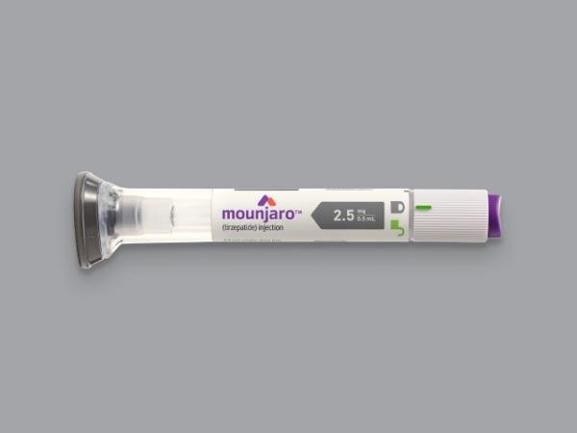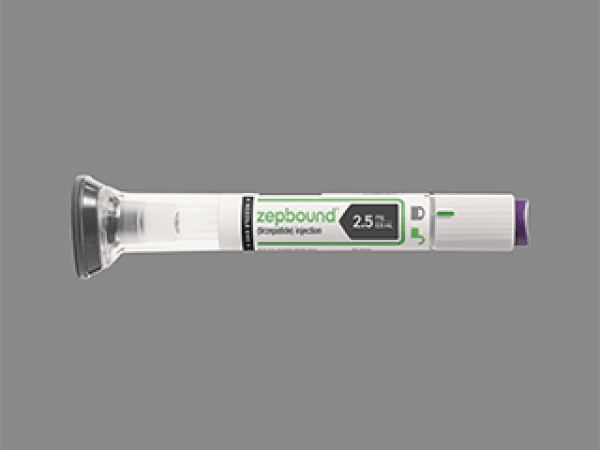
Pronunciation: mown-JAHR-OH
Generic name: tirzepatide
Dosage form: injection, for subcutaneous use
(2.5 mg, 5 mg, 7.5 mg, 10 mg, 12.5 mg,15 mg per 0.5 mL in single-dose pen or vial)
Drug class:Incretin Mimetics (GLP-1 Agonists)
What is Mounjaro?
Mounjaro (tirzepatide) is used for type 2 diabetes to help lower blood sugar levels, and tirzepatide also causes weight loss. Mounjaro is a once-weekly injection that should be used along with diet and exercise. Mounjaro works by helping the pancreas release more insulin, lowering the amount of sugar your liver makes, and slowing the rate food passes through your body, making you feel full longer.
Clinical trials for a 15 mg dose of Mounjaro (tirzepatide) for weight loss showed patients lost a mean of 20.9% of their body weight compared to 3.1% for a placebo over 72 weeks. Zepbound is the brand name of the weight loss version of Mounjaro; they both contain the same active ingredient (tirzepatide). Mounjaro is FDA-approved for type 2 diabetes in adults, and Zepbound is FDA-approved to help with weight loss in adults.
In another clinical trial (SURMOUNT-1), tirzepatide delayed the progression to diabetes in adults with pre-diabetes and obesity or who were overweight.
Mounjaro injection became an FDA-approved medicine on May 13, 2022, to improve blood sugar (glucose) levels in adults with type 2 diabetes mellitus when used together with diet and exercise. Mounjaro TGA (Therapeutic Goods Administration) approval was on September 11, 2024, in Australia. Mounjaro is not for use in people with type 1 diabetes. It is not known if this medicine can be used in people who have had pancreatitis.
How Does Mounjaro Work?
Mounjaro works like two natural hormones in our bodies, called GIP and GLP-1, which help control appetite, blood sugar levels, and digestion. When Mounjaro binds to GIP and the GLP-1 receptors, the pancreas releases more insulin, lowers the amount of sugar your liver makes, and slows the rate food passes through your body, making you feel full longer. This helps lower blood sugar levels and helps weight loss. Mounjaro is a GIP and GLP-1 receptor agonist. Mounjaro’s mechanism of action is by activating both GIP (glucose-dependent insulinotropic polypeptide) and GLP-1 (glucagon-like peptide-1) hormone receptors.
What is the Cost of Mounjaro?
Mounjaro cost will depend on your insurance plan and which pharmacy you use.
Mounjaro coupon or a Mounjaro savings card may be available that you could be eligible for. Ask your doctor or pharmacist if you qualify, or click on this link for Mounjaro Coupons and our price guide.
Has the FDA Approved Mounjaro for Weight Loss?
Yes, Mounjaro’s active ingredient, tirzepatide is approved for weight loss, but it is under the brand name Zepbound. Zepbound has the same active ingredient as Mounjaro, and Eli Lilly and Company make both.
The Mounjaro brand is not approved by the FDA for weight loss. Mounjaro is an FDA-approved medicine used to improve blood sugar (glucose) levels in adults with type 2 diabetes mellitus when used together with diet and exercise.
Mounjaro’s active ingredient, tirzepatide, was used in the Phase 3 SURMOUNT-1 72-week weight loss clinical trials. The mean tirzepatide weight loss was 15% for the 5mg dose, 19.5% for the 10mg dose, 20.9% for the 15mg dose, and 3.1% for the placebo. The trial included patients who were overweight, obese, and had a weight-related health issue but excluded patients with diabetes.
What are the side effects of Mounjaro?
Common Mounjaro side effects
The most common Mounjaro side effects include nausea, diarrhea, decreased appetite, vomiting, constipation, heartburn (dyspepsia), and abdominal pain, which affects 5% or more patients.
Stomach or gastrointestinal Mounjaro side effects are common but tend to be mild and improve after a few weeks in most people and do not interfere with long-term treatment. Stomach side effects can be more common with higher doses.
The most common gastrointestinal Mounjaro side effect is nausea, which occurs in about 12% to 18% of people.
Other side effects include vomiting (5% to 9%), diarrhea (12% to 17%), stomach-area pain (5% to 6%), and constipation (6% to 7%).
These side effects occurred at rates higher than the placebo-treated groups (receiving an inactive treatment).
More patients receiving Mounjaro 5mg (3.0%), 10 mg (5.4%), and 15mg (6.6%) discontinued treatment due to stomach side effects than patients receiving placebo (0.4%).
Stomach side effects usually occur at the beginning of treatment and if your dose is increased too quickly. Because of this, your healthcare provider will slowly increase your dose every 4 weeks as needed until you reach your target dose. You can take this medicine with or without meals.






